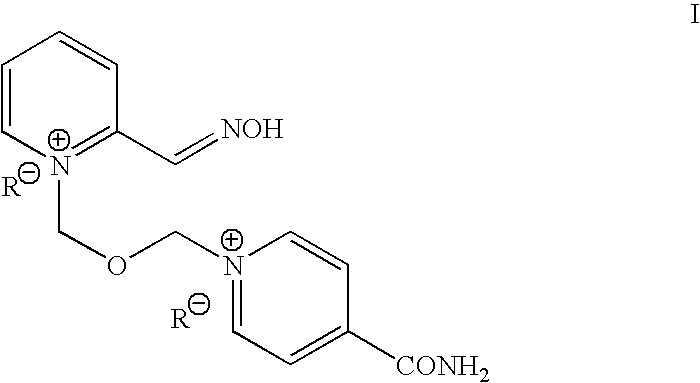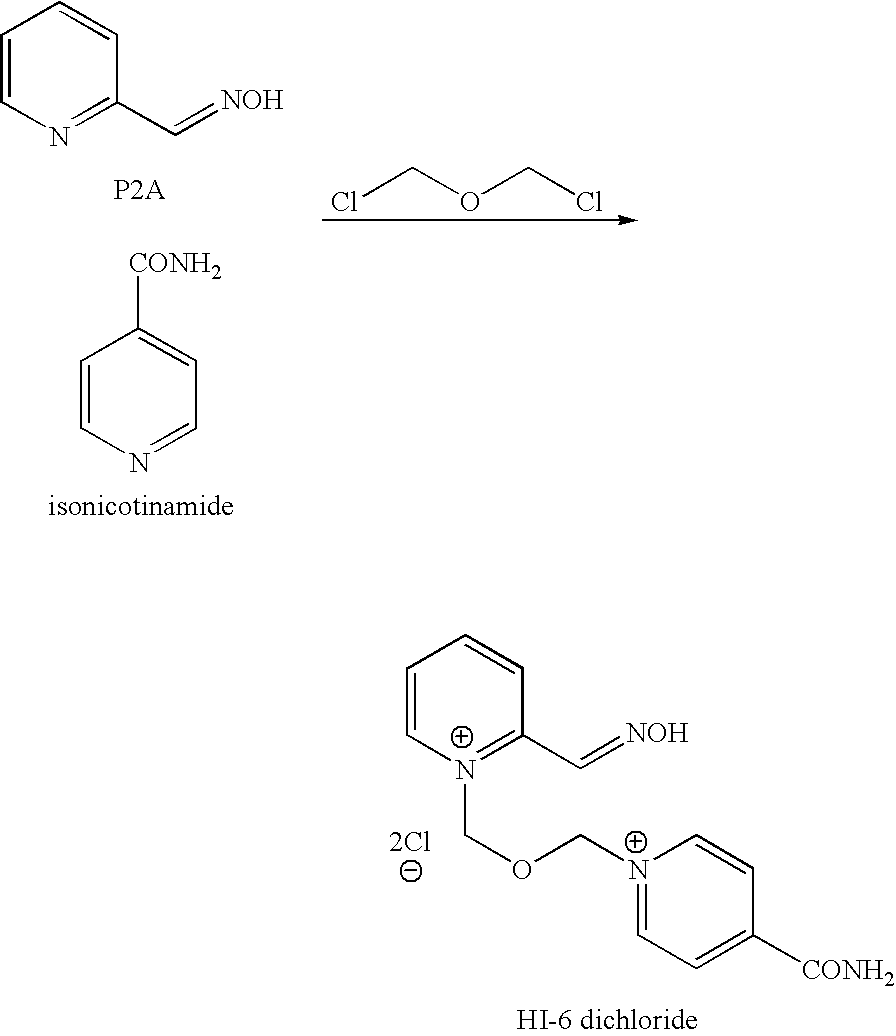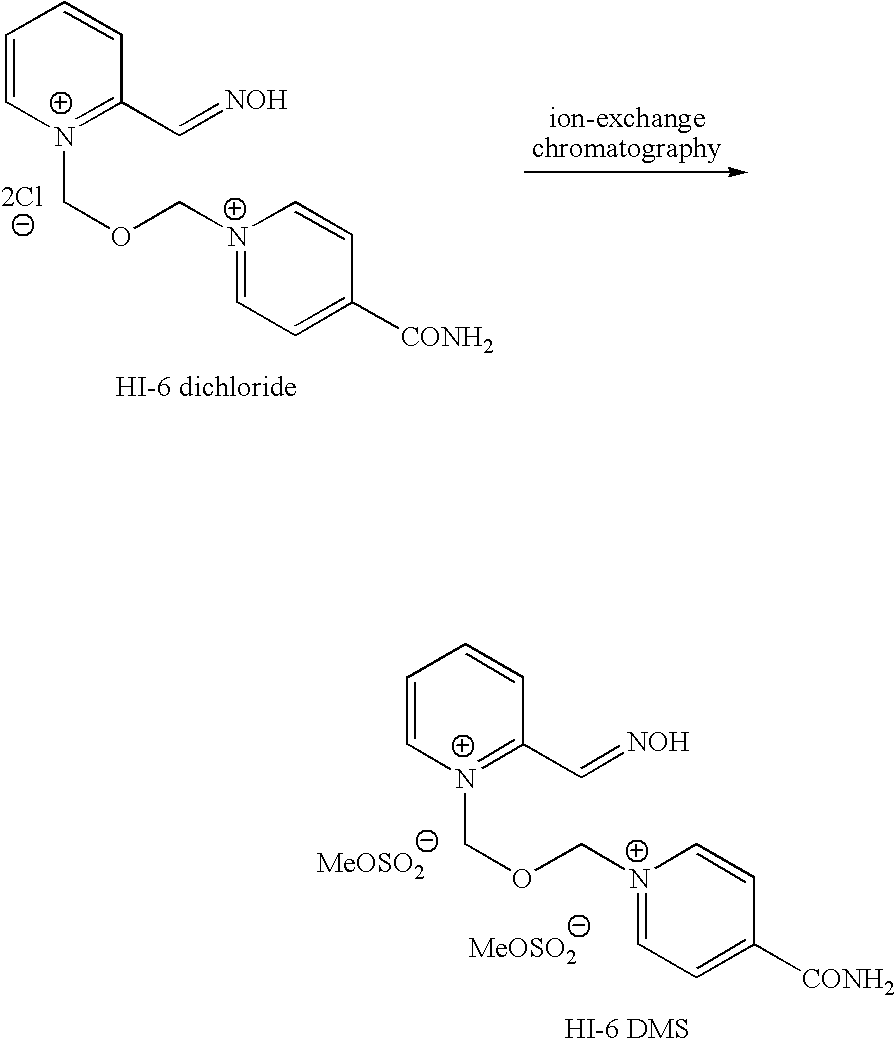Process for the manufacture of HI-6 dimethanesulfonate
a technology of dimethanesulfonate and process, which is applied in the field of process for the manufacture of hi6 and can solve the problems of adverse health effects of any person involved in its manufacture, storage, transportation or use, and the toxicity of the reagent bis(chloromethyl)ether, so as to achieve commercially satisfactory product yield and/or purities, and avoid the effect of us
- Summary
- Abstract
- Description
- Claims
- Application Information
AI Technical Summary
Benefits of technology
Problems solved by technology
Method used
Image
Examples
example 1
Preparation of HI-6 DMS
[0048]
[0049]To a solution of BSME (2.89 g) and acetonitrile (11.3 g) was slowly added a solution of P2A (2.03 g) in chilled (−20° C.) tetrahydrofuran (71.2 g) over 30 minutes under nitrogen. The solvent was partially evaporated over 2 hours and acetonitrile (11.3 g) and tetrahydrofuran (71.2 g) was added to form a gum. The supernatant liquid was decanted and acetonitrile (14 ml) added to the gum. Isonicotinamide (1.2 g) was added and the mixture stirred at room temperature for 20 hours. The solvent was removed under reduced pressure and the residue triturated with ethanol (49.5 g). The slurry was filtered to remove isonicotinamide dimer. The filtrate was stirred overnight. The solid was collected by filtration and the cake washed with ethanol to yield HI-6 DMS (1.9 g, 90% area by HPLC, 29% th. yield).
example 2
Preparation of HI-6 DMS
[0050]To a solution of BSME (2.89 g) and acetonitrile (11.3 g) was slowly added a solution of P2A (2.03 g) in acetonitrile (17.8 g) over 1.5 hours under nitrogen and the mixture stirred for 20 hours. Isonicotinamide (1.2 g) and acetonitrile (3.95 g) was added and the mixture stirred at room temperature for 20 hours. The solvent was removed under reduced pressure and the residue triturated with ethanol (49.5 g). The slurry was filtered to remove ‘isonicotinamide dimer’. The homogeneous filtrate was stirred overnight. The solid was collected by filtration and the cake washed with ethanol to yield HI 6 DMS (2 g, 85% area by HPLC, 30% th. yield). The crude HI-6 DMS was recrystallised form aqueous ethanol to give 1.2 g HI-6 DMS (>98% area by HPLC). This is a 21% overall yield from P2AOAc.
example 3
Preparation of HI-6 DMS
[0051]Solid BSME (20 g, 84.0 mmol, 1.2 moleq.) was charged to a dry vessel under N2 and a solution of P2AOAc (11.6 g, 70.0 mmol, 1.0 moleq) in MDC / acetonitrile (85.3 g / 9.2 g) was added. The mixture was stirred for 6 hours and then isonicotinamide (11.4 g, 93.3 mmol) in dimethylformamide (25.8 g) was added. The mixture was stirred out for 17 hours. Ethanol (370 g) was added and the mixture was stirred for ca 6 hours. The resulting slurry was filtered. The homogeneous filtrate was then placed in a vessel and stirred until deprotection was complete. The resulting slurry was then filtered to give 17.8 g (53% yield based on P2AOAc) of an off-white powder (HPLC 95% by area). 5 g of this cake was then re-crystallized from aqueous ethanol (44.4 g) to give 3.9 g of a white solid, HPLC (>99% by area); 1H NMR (D2O, 250 MHz): δ 2.67 (s, 6H), 6.22 (s, 2H); 6.34 (s, 2H); 8.03 (m, 1H); 8.42 (m, 3H); 8.60 (m, 2H), 8.98 (d, 1H); 9.14 (d, 2H)ppm. 13C NMR (D2O, 63 MHz): δ 38.48 ...
PUM
| Property | Measurement | Unit |
|---|---|---|
| transparent | aaaaa | aaaaa |
| chemical formula | aaaaa | aaaaa |
| solubility properties | aaaaa | aaaaa |
Abstract
Description
Claims
Application Information
 Login to View More
Login to View More - R&D
- Intellectual Property
- Life Sciences
- Materials
- Tech Scout
- Unparalleled Data Quality
- Higher Quality Content
- 60% Fewer Hallucinations
Browse by: Latest US Patents, China's latest patents, Technical Efficacy Thesaurus, Application Domain, Technology Topic, Popular Technical Reports.
© 2025 PatSnap. All rights reserved.Legal|Privacy policy|Modern Slavery Act Transparency Statement|Sitemap|About US| Contact US: help@patsnap.com



